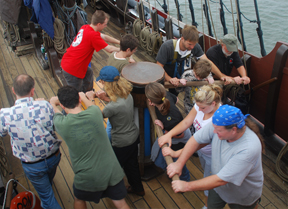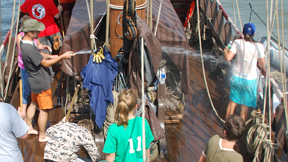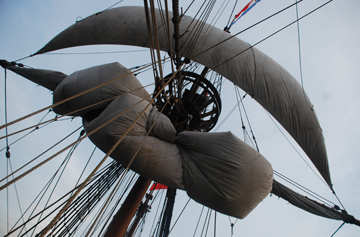 |
|
|

0700 hours
Current Position: Anchored at Haverstraw Bay.
Latitude: 41˚ 15.8'
Longitude: 072˚ 28.8'
Day Two of the second leg of our Fall 2008 Voyage of Discovery, and our new crew's first full day on board the ship.
And what a remarkable day it will turn out to be!
|

0915 hours
After the crew has been roused and eaten breakfast, we begin our day. Nicole reports to galley duty, and helps Mr. Gorter chop vegetables for lunch.
|

0930 hours
We have a steady southerly wind to our back -- ideal sailing weather, if one can ignore the increasingly muggy humidity. (Yes, the weather today really does feel as steamy as these photos appear.) Both the winds and the humidity are the product of an approaching high pressure front approaching from the south.
To prepare for a morning of sailing, we send our climbers aloft to unfurl (remove the protective lashings from) the sails.
|

This is the first opportunity for the student crew to climb to the tops -- and it won't be the last.
With many hands at work, the tops and courses are soon unfurled, and our climbers return to the deck.
|

0945 hours
With our preliminary work done, Captain Reynolds convenes the crew on the weather deck. He briefs everyone as to our plans for the day, and reads several entries from the journal of Robert Juet. You can read these entries at the end of each Daily Log entry, or just click here to download the entire journal as a PDF file.
|
Mouse over
to walk the capstan.
 |
1000 hours
With our morning tasks done, we turn our attention to weighing anchor. One note that will later be worth consideration is that we have planned on a leisurely day of travel. Our departure is not scheduled to take maximum advantage of the flood tide -- we're just moving out when we feel we're ready.
To weigh the anchor, we divide the entire crew into several teams. On the weather deck, the capstan crew walks the capstan, using the mechanical advantage it provides to haul in the anchor rode.
|

The below decks team is stationed on the orlop deck, where the anchor rode actually runs. At the fore end of the deck, Ms. Smith oversees the team while tending the bits. Her task is to maintain control over the rode by making it off on the Sampson bar.
Next to hear, Devin and Ryan are today's fakers; their job is to fake (neatly fold) the anchor rode after it has passed around the capstan.
|

Astern, Derrick and Tyler W. monitor the rode as it passes around the lower capstan itself, preventing overrides (tangles). Click here to see them at work.
|

1030 hours
Captain Reynolds has opted to start the day without the assistance of the engine. Having just successfully raised the anchor without falling back on the engine to reposition the ship, we now set sail.
|

Yesterday's mast teams report back to their positions as we adjust the tops and courses to maneuver. Successfully tacking against the wind, we turn north and are soon on our way under the Newburgh-Beacon Bridge.
|

1100 hours
Once the ship is on course and clear of the bridge, the crew returns to their other tasks. As part of maintaining the Deck Log, Dr. Jacobs directs Jamie and Ryan through testing a water sample for salinity levels.
|

To update some unfortunate news from the first leg of the voyage, Ann McGuinness is still recovering at home. Hearing that she's on the mend, Captain Reynolds is back in good spirits, marking the occasion by trying out a new sun hat.
It doesn't last long.
|

1115 hours
Aha! We've caught our bounty early on this voyage -- the elusive, yet ever popular head maintenance photo.
A parent has written in, asking why the ship's bathroom is called the head. The answer dates back to Henry Hudson's era, when sailors typically used the very front of the ship -- known as the "beak" or "head," where the spritsail is rigged and operated -- to go to the bathroom. (This was the one location where the wind was most certain to be blowing away from the ship.)
The bathroom on a ship is thus traditionally still called "the head" to this day.
|

As we sail north out of Haverstraw Bay, attracting the curiosity of weekend boaters and jetskiiers as we go, the students take the day to get to know the ship, exploring its nooks and crannies.
|
1130 hours
 
We are now passing our frequent host, King Marine at Verplanck, NY, and elect to fire off a cannon salute. Mr. Prime has Nicole hold the match and keep it lit (by blowing on its embers) while he prepares the cannon. When he actually gives fire, however, Nicole (and the rest of the students) are restricted to the weather deck as a standard safety precaution.
|

1245 hours
The wind is holding and we are now sailing past Peekskill, with the Bear Mountain Bridge just coming into view.
|

Mr. Gorter serves soup and quiche for lunch on the orlop deck. It's an immediate hit.
|

1315 hours
After lunch, Mr. Terry and Mr. Beiter take Devin aside to deliver some dire news: He's been appointed watch leader for the rest of this shift. As watch leader, he is the head of his watch team, and is in charge of ensuring that his watchmates promptly report to their duties. A different student will be rotated into the position of watch leader for each six-hour shift.
Devin accepts responsibility over his peers with a grim sort of determination. Still, at least there's a bit of blue tape in it for him!
|

1330 hours
As the Half Moon approaches Bear Mountain Bridge, we opt to send out the Zodiac, the ship's inflatable tender boat, to take a few glamour shots of our passage.
|
Mouse over
to use the Secchi disk.
 |
While the Zodiac buzzes around the ship, the students continue with their orientation work. Here, Tyler W. and Ryan use the Secchi disk to test the water's turbidity from the port channel.
|

We want to take these photos now, because once we pass Bear Mountain Bridge we will have entered the Hudson Highlands. This narrow, deep section of the river is surrounded on all sides by high, sloping peaks, which usually choke off the wind.
|

As the Half Moon rounds the bend, however, we find we're in luck. The southerly wind is still with us, filling out all six sails.
|

Mouse over to sweat the stern tackles.
 |
1345 hours
As the Zodiac returns to the ship, the senior crew hoist it out of the water.
|

The wind may still be at our back, but once in the Highlands it would be an exaggeration to call it more than a puff. Now sailing against the current, we are now traveling at an average speed of 1.5 knots (nautical miles per hour).
In other words, we are moving, but only just barely. The officers discuss whether we should douse the sails and strike up the engine, and it's a close call. For now, however, we opt to keep sailing.
|

1400 hours
Deck Log work continues in the meantime. As the students gather data for the Deck Log, they are also using the experience to determine what natural phenomena and experiments most appeal to them as presentation projects.
|

As the afternoon continues, the heat and humidity are starting to wilt our hearty crew. The Quarter deck officers take pity on Cheyenne as she takes her hour at the helm. To offer her a bit of shade, they close the hatch that allows her to see and the cabin doors. Working in near-complete darkness, Cheyenne steers the ship by vocal command only.
|

The rest of the crew need some relief too. The call goes out for another deck wash. As we spray down the decks, the ambient temperature on the ship grow noticably more comfortable.
|
Mouse over
to cool off the crew.
 |
Of course, when dealing with a cool hose on a hot day, it's just a matter of time before some youngster breaks out the horseplay.
|
 
If you don't want to get sprayed, this is the wrong time to be on deck!
Some crew members don't just cool off -- they take this as an opportunity to break out the shampoo and take an actual bath. (Well, as close as we can get to one on board, anyway.)
We wait until Mr. Morel and Ms. Smith are thoroughly lathered up before declaring we're done with the deck wash and ordering the hose turned off.
|

1500 hours
Now that the crew is feeling better, they go back to work and relaxation. On the fore deck, Mr. Prime and Mr. Morel teach Tyler W. and Derrick some knots.
|

1515 hours
As we continue moving through the winding course of the Hudson Highlands, we occasionally need to adjust the sails to recapture what little wind we have.
Here, Alexis and Mr. Terry haul in the sheet as we brace the main course to starboard.
|

1545 hours
We are now passing West Point, located at the deepest point on the entire Hudson River. The water hear plunges 180 feet to the bottom -- deep enough to stack three Half Moons on top of each other without breaking the surface.
|

1730 hours
The senior crew have returned to the topic of whether we should surrender the sails and turn on the engine. Our destination for the day is nearby -- the Newburgh-Beacon Bridge -- but how long it will take us to reach that point is very much in question.
Having come this far, can we afford to continue sailing, or do we need the aid of modern technology?
|
 
While the officers debate the pros and cons of our next course of action, the student crew remain blissfully unaffected by such ponderous concerns.
|

1800 hours
To resolve the sail/engine dillemma, Captain Reynolds requests that the students chart our position and determine how long it will take the Half Moon to reach anchorage under sail, based on the distance to the bridge and our current average speed.
Alexis, Elora, Derrick, and Tyler W. are on hand to take up the challenge, and their results are discouraging. According to their calculations, at our current speed it will take four hours to reach the Newburgh-Beacon Bridge -- which is already within visual range.
Is this how our day of sailing ends?
|

Meanwhile, i n less ominous circumstances, Ryan has been hard at work during his galley duty. As his hour runs out, he puts the finishing touches on his fruit salad.
|

1815 hours
A stroke of luck! Just as we are about to give up on sail power, the Half Moon nears the end of the Highlands, fresh winds fill our sails, and the ebb current turns to flood.
These variables have completely changed the equation, and now the ship starts slicing across Newburgh Bay.
|

1830 hours
As we close in on our target, dinner is served on the orlop and eagerly devoured.
|

1845 hours
The Sun is setting quickly, and Captain Reynolds has determined that we will not be at anchor until shortly after nightfall. To make life easier on the crew, he orders the crew to douse most of the sails now. This will slow our progress, but will also reduce the amount of work that will be required aloft after dark.
|
Mouse over for a close up.
 |
1900 hours
We strike the top sails. In the main top, Mr. Terry waits to help pull the sail into the basket. That done, he immediately sets about furling it. Mr. Beiter does the same in the fore top.
|

At the same time, Mr. Morel oversees John and Ms. Smith in the beak (the infamous true "head" of the ship) to douse the spritsail.
|

1915 hours
As Ms. Smith works on furling the spritsail, we close in on our anchorage. We will be spending the night just south of the Newburgh-Beacon Bridge, on the Beacon side of the river, well out of the main channel/
|

While Ms. Smith works, the fore deck crew turns their attention to unlashing the anchor and lowering it to the waterline.
|

1930 hours
While the senior crew focus on the anchor, the fore mast team reports to duty alongside them. Once the anchor is set, the students will put the fore course in its gear.
|

The order comes to set the anchor. Without using the engine to slow the ship's advance -- particularly in the face of mounting southerly winds -- this requires fast reflexes, but our crew handles the task with efficiency.
However, the same mounting winds that carried us to anchor are forecast to continue building through the night. We put out 300 feet of anchor rode -- the usual range being 100 to 200 feet -- as a countermeasure against dragging anchor in the night.
|

1945 hours
As night settles over the Newburgh waterfront, senior climbers ascend the rig to furl the remaining sails.
This day has become an event of historical note; without ever turning on the engine, the Half Moon has successfully weighed anchor in Haverstraw Bay, sailed through the entirety of the Hudson Highlands, and then set anchor at Beacon. And all this done without synchronizing our travel time to the flood tide.
Ships in the great Age of Sail could have done no better!
|

2015 hours
With all long and successful day of work behind them, the top mast crew and their assistants finally sit down to dinner -- not to mention dessert of ice cream on fruit salad.
|

2100 hours
The student crew is more than happy to call it an early night. After the captain's anchor watch briefing, they retreat to their bunks to update their journals.
At 2200 hours, the lights go out, and anchor watch begins. Starting tonight, by popular demand, crew members on anchor watch will also maintain a limited version of our Deck Log readings overnight as well. (Specifically, air temperature and relative humidity.)
As if that's not enough to keep our nocturnal students alert, the high winds alert still hangs over us. If the Half Moon is going to drag anchor at any point during this voyage, tonight is likely when it will happen.
Next Time: Sailing Through Orientation!
|
On this date in 1609:
The fourteenth, in the morning being very faire weather, the wind South-east, we sayled up the River twelve leagues, and had five fathoms, and five fathoms and a quarter lesse; and came to a Streight between two Points, and had eight, nine, and ten fathoms: and it trended North-east by North, one league: and wee had twelve, thirteene and fourteene fathomes. The River is a mile broad: there is very high Land on both sides. Then wee went up North-west, a league and an halfe deepe water. Then North-east by North five miles; then North-west by North two leagues, and anchored. The Land grew very high and Mountainous. The River is full of fish.
-- Robert Juet's Journal.
|
|
|
|
|
|

